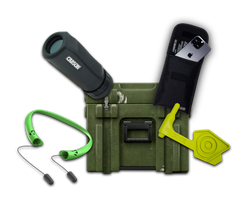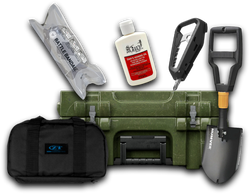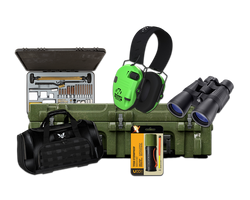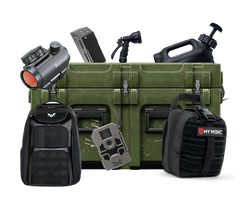How Long is an M16 Rifle? Understanding the Specifications and Significance
Table of Contents
- Introduction
- The M16: An Overview
- Historical Context
- Performance Characteristics
- Conclusion
- FAQ Section
Introduction
When discussing military firearms, the M16 rifle stands as one of the most iconic and widely recognized weapons in modern history. Designed in the late 1950s, the M16 has undergone numerous iterations and modifications, becoming a primary infantry weapon for the U.S. military and many armed forces worldwide. But just how long is the M16 rifle? The answer goes beyond mere measurements; it encompasses the rifle's evolution, its operational context, and its impact on military engagements.
In this blog post, we will explore the M16's specifications, including its length, weight, and performance characteristics. We'll also delve into its historical significance, development, and the various models that have emerged throughout its service life. By the end of this post, you will have a comprehensive understanding of the M16 rifle, its dimensions, and its role in military operations.
The M16: An Overview
The M16 rifle, originally designated as the Rifle, Caliber 5.56 mm, M16, is a family of assault rifles adapted from the ArmaLite AR-15 design. The rifle was first adopted by the U.S. military in the 1960s and has seen extensive use in various conflicts, particularly during the Vietnam War.
The M16's design focuses on lightweight construction, high accuracy, and the ability to deliver a high volume of fire. Its 5.56×45 mm caliber provides a balance between manageable recoil and lethal effectiveness, making it suitable for a wide range of combat scenarios.
Key Specifications
- Overall Length: The standard M16A2 variant measures approximately 39 inches (100 cm) in length. This is a significant reduction from its predecessor, the M14, which measured around 44 inches (112 cm).
- Barrel Length: The M16 typically features a 20-inch (51 cm) barrel, which contributes to its accuracy over longer distances.
- Weight: The M16A2 weighs around 8.8 pounds (approximately 4 kg) when loaded with a 30-round magazine.
- Effective Range: The M16 is designed for effective engagement of targets up to 550 meters for point targets and 800 meters for area targets, showcasing its capabilities in various combat situations.
These specifications highlight the M16's design philosophy aimed at creating a more versatile and effective infantry weapon compared to its predecessors.
Historical Context
The M16's development can be traced back to the U.S. military's need for a reliable, lightweight rifle that could effectively engage enemy forces in diverse environments. The rifle was born from the experiences of World War II and the Korean War, where soldiers needed a weapon that could deliver accurate fire without the burden of excessive weight.
Development and Adoption
Eugene Stoner, an engineer at ArmaLite, designed the AR-15 in the late 1950s. The rifle's lightweight construction and innovative gas-operated mechanism made it a compelling candidate for military service. After several modifications and testing phases, the rifle was officially adopted by the U.S. military as the M16 in 1964.
The M16 was first deployed in combat during the Vietnam War, where its lightweight design was particularly advantageous in the dense jungles. However, the initial versions faced reliability issues, leading to a series of updates and improvements throughout the conflict.
Evolution of the M16
Over the years, the M16 has evolved through various models, each incorporating enhancements based on battlefield feedback. The most notable variants include:
- M16A1: Introduced in 1967, this model included improvements such as a chrome-plated chamber to increase reliability and a forward-assist feature to help seat cartridges.
- M16A2: Adopted in the early 1980s, the M16A2 replaced the fully automatic firing mode with a three-round burst capability, aimed at improving accuracy and conserving ammunition.
- M16A4: The latest version, introduced in the late 1990s, features a flat-top receiver with a Picatinny rail for mounting optics and accessories, further enhancing its versatility in modern combat scenarios.
Each iteration of the M16 has contributed to its reputation as a reliable and effective service rifle, tailored to meet the evolving needs of military operations.
Performance Characteristics
Accuracy and Range
One of the defining features of the M16 is its exceptional accuracy. The 20-inch barrel contributes to a higher muzzle velocity, allowing for effective engagement at longer distances. The M16 is capable of achieving tight groupings, making it suitable for precise shooting in combat situations.
Recoil Management
The M16's direct impingement gas system helps mitigate recoil, allowing for rapid follow-up shots. This characteristic is particularly beneficial for soldiers in high-stress combat situations, where maintaining control over the weapon is crucial.
Lightweight Design
The use of lightweight materials, including aluminum and composite plastics, contributes to the M16's manageable weight. This allows soldiers to carry more ammunition and equipment without being hindered by the weapon's bulk.
Versatility in Combat
The M16's design supports a range of accessories, including grenade launchers, scopes, and tactical lights. This adaptability allows soldiers to customize their rifles for specific missions, enhancing their effectiveness in various combat environments.
Conclusion
In summary, the M16 rifle measures approximately 39 inches in length and weighs around 8.8 pounds when loaded. Its innovative design, historical significance, and performance capabilities have made it a cornerstone of modern military arsenals. The M16 has undergone numerous enhancements, ensuring its relevance in contemporary warfare.
As you explore tactics and equipment for outdoor adventures or tactical preparedness, consider the legacy of the M16. The rifle's versatility and reliability continue to influence the design and functionality of modern firearms, demonstrating the importance of quality gear in any tactical situation.
For those interested in high-quality tactical gear, Crate Club offers a subscription service tailored to meet your preparedness needs. Explore our subscriptions to find the right gear for your next adventure! Check out the Crate Club Subscription Services and enhance your tactical readiness today!
FAQ Section
1. How long is an M16 rifle?
The standard M16 rifle measures approximately 39 inches (100 cm) in overall length.
2. What is the weight of an M16?
The M16A2 variant weighs around 8.8 pounds (approximately 4 kg) when loaded with a 30-round magazine.
3. What is the effective range of the M16?
The M16 is effective up to 550 meters for point targets and 800 meters for area targets.
4. What are the main differences between the M16A1 and M16A2?
The M16A2 replaced the fully automatic feature of the M16A1 with a three-round burst capability, aimed at improving accuracy and reducing ammunition consumption.
5. Is the M16 still in use today?
Yes, while the M4 carbine has largely replaced the M16 in frontline combat units, the M16 remains in use by various military and law enforcement agencies around the world.
6. Where can I find quality tactical gear?
Crate Club offers a range of tactical gear and survival tools through their subscription service. Visit the Crate Club Shop to explore our curated selection of high-quality gear for your tactical needs.
Compartilhe este artigo



